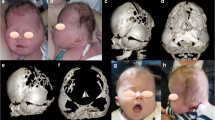Abstract
Background
Isolated synostosis of the frontosphenoidal suture is very rare and difficult to diagnose. Little has been reported on the clinical presentation and fetal development of this suture.
Objective
To understand the development of the frontosphenoidal suture and the outcome of its synostosis.
Materials and methods
We studied the normal fetal development of the frontosphenoidal suture in dry human skulls and the clinical features of four patients with isolated synostosis of the frontosphenoidal suture.
Results
The frontosphenoidal suture develops relatively late during the second trimester of pregnancy, which explains the mild phenotype when there is synostosis. This rare craniosynostosis results in a deformity that causes recession of the lateral part of the frontal bone and supraorbital rim, with minimal facial asymmetry. Three-dimensional CT is the best examination to confirm the diagnosis.
Conclusion
Isolated frontosphenoidal synostosis should be considered in patients with unilateral flattening of the forehead at birth that does not improve within the first few months of life.







Similar content being viewed by others
References
Seeger JF, Gabrielsen TO (1971) Premature closure of the frontosphenoidal suture in synostosis of the coronal suture. Radiology 101:631–635
Dundulis JA, Becker DB, Govier DP et al (2004) Coronal ring involvement in patients treated for unilateral coronal craniosynostosis. Plast Reconstr Surg 114:1695–1703
Rogers GF, Mulliken JB (2005) Involvement of the basilar coronal ring in unilateral coronal synostosis. Plast Reconstr Surg 115:1887–1893
Francel PC, Park TS, Marsh JL et al (1995) Frontal plagiocephaly secondary to synostosis of the frontosphenoidal suture. J Neurosurg 83:733–736
Rogers GF, Proctor MR, Mulliken JB (2002) Unilateral fusion of the frontosphenoidal suture: a rare cause of synostotic frontal plagiocephaly. Plast Reconstr Surg 110:1011–1021
Mathijssen IM, Vaandrager JM, van der Meulen JC et al (1996) The role of bone centers in the pathogenesis of craniosynostosis: an embryologic approach using CT measurements in isolated craniosynostosis and Apert and Crouzon syndromes. Plast Reconstr Surg 98:17–26
Mathijssen IM, van Splunder J, Pieterman H et al (1999) Tracing craniosynostosis to its developmental stage through bone center displacement. J Craniofac Genet Dev Biol 19:57–63
Acknowledgement
We would like to thank Dries van Dam, conservator of the Museum of Anatomy of the Leiden University Medical Centre, for allowing us to use the fetal skeletons.
Author information
Authors and Affiliations
Corresponding author
Rights and permissions
About this article
Cite this article
Mathijssen, I.M.J., van der Meulen, J.J.N.M., van Adrichem, L.N.A. et al. The frontosphenoidal suture: fetal development and phenotype of its synostosis. Pediatr Radiol 38, 431–437 (2008). https://doi.org/10.1007/s00247-008-0750-z
Received:
Revised:
Accepted:
Published:
Issue Date:
DOI: https://doi.org/10.1007/s00247-008-0750-z




